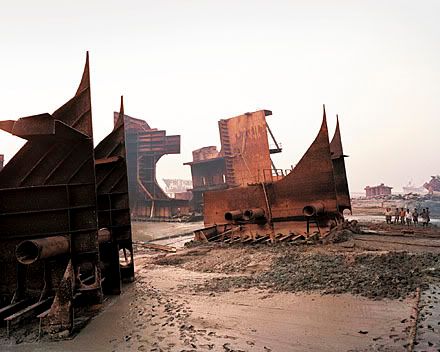April 26, 2009
Big things

Edward Burtynsky takes pictures of big things. His photos capture scenes that, the more I see, remind me of how small I am in comparison. It's frightening, not to see, but to feel how tiny you really are. Check out Manufactured Landscapes, a documentary of his photography.
I just finished reading a chapter of The New New Journalism, in which William Langewiesche describes his approach to storytelling. He says he tends to rebel against the idea that we live in a small world. He hates the phrase.
If there's a unifying theme to my work, it is that the "small world" idea is a myth, a serious misreading of our times. It's obvious why it exists -- jet travel, the Internet, the globalizations of markets, the similarity of hotel rooms. But these are largely superficialities. The real world -- of the history-making kind -- simply is not defined by the ease and speed with which people can flit around the globe.He goes on to argue the size of the world is based not on physical geography, but by human constructs.
Burtynsky, Langewiesche and my own fearful curiosity of mega-objects meet in Alang, India where people make their living ripping apart ships for scrap metal.
A photo was taken. A story was written.
Langewiesche makes a case for how reporting on the shipbreaking industry in Alang usually ends in failed attempts at good storytelling. Reporters, environmentalists, and statesmen approach these people and ask them questions like, "Why do you work here in this very unhealthy environment? Are you unaware of the poisons and dangers?"
He says those are by and large what most people ask them, and it's insulting. Of course they know these things, he says, they're making the rational choice to be there. It plays into his idea of how the world is actually huge...maybe even expanding...because of the differing human ideas.
I thought about Langewiesche when I listened to a recent interview on This American Life (#378 - "This I Used to Believe"). A woman struggling with her Christianity came to contact the coach of a Christian high school football team from Texas.
She was struggling with a big idea, the Christian god, and it was interesting because the coach went about explaining Christianity to her in the worst possible way: he gave her pre-packaged answers about free will and God and the fallen world.
Afterward, she's still full of questions, maybe even a little more confused.
It's the reminder of how important it is to approach stories and people and ideas that got me thinking. I doubt I'll ever cover anything as big as those shipbreakers, but I think Langewiesche holds some good rules for reporting, no matter how big the idea.
Labels: Burtynsky, photography, The Atlantic, This American Life, writing
3 Comments:
Good post. I think Langewiesche is dead on. Reality is as much (more?) rooted in the human mind than with the material world. We don't create the world, but we do invent our universe.
One of the two key phrases in Jailbird, which I am reading now, is "small world."
The other is "peace."
Peace.
I don't know, Chase. Bigness and smallness are both easily cliched. And maybe they're not even good metaphors for how we construct our reality, because both are true and both always seem to be tipping into meaninglessness. I write you from half-a-world away, but does that mean the world is bigger or smaller? Or both or neither? In Germany, kids watch Paris Hilton on TV and have posters of Pulp Fiction characters up on their walls, and this is a prime example of globalization, but really which spacial metaphor makes this make sense?
I tend to like wide, as a spacial metaphor, but mostly for its alliteration with weird and wild.
Post a Comment
<< Home